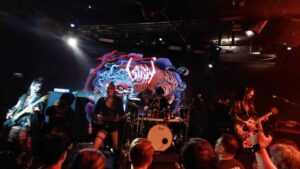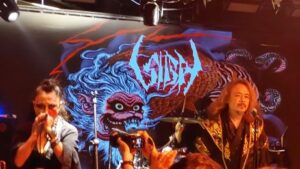
It was my birthday a while ago and my lovely mother-in-law sent me a batch of rock-music-themed T-shirts as a present. One was emblazoned with the striking cover-illustration of the 1998 album Cruelty and the Beast by County Suffolk gothic / symphonic heavy metal band Cradle of Filth. Cruelty and the Beast was a concept album inspired by the legendary 16th / 17th century Hungarian countess Elizabeth Bathory, who supposedly bathed in the blood of slaughtered virgins in an attempt to keep herself young-looking. (Fittingly, the album featured narration by the late, great horror-movie actress Ingrid Pitt, who played Bathory in the 1971 Hammer film Countess Dracula.) Anyway, I’d been waiting for an opportunity to wear this new T-shirt in public. The opportunity arrived on October 16th, when Japanese black metal band Sigh performed at Singapore’s Phil Studio.
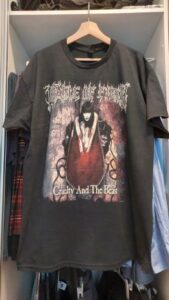
Actually, my T-shirt matched the macabre vibe established by the second support act, the Singaporean Tok Yathraa. (I couldn’t get away from work early enough to catch the first support act, which was N3M3515 – read the numbers as letters – described intriguingly as a “one-man ChipDoom Project from Singapore, armed with a Classic Gameboy, combining elements from Sludge Doom and Hardcore.”) Tok Yathraa is a black-shrouded, hooded, white-faced, rather Bergmanesque figure who, when interviewed on the Filthy Gods of Metal website, described himself as “a one-man band which started on 16th May 2020… heavily influenced by King Diamond, Mercyful Fate, Black Sabbath, Immortal, S.M. Salim, Judas Priest and Wings.” It might come as a shock for the classic Malay singer S.M. Salim or, indeed, Paul McCartney’s Wings to find themselves included in such illustriously metallic company. In the same interview, he called his music “bomoh metal, a fusion of black metal plus heavy metal plus focusing on subjects of local / Asia ghosts.”
Now fronting a three-piece band with a drummer and bass-player, Tok Yathraa put on a show that was simultaneously spooky and good fun, with his references to the ghosts and folklore of the Malay Peninsula nicely anticipating Halloween at the end of this month. He went down well with the small but enthusiastic crowd whom, at the beginning of his set, he encouraged to stand close to the stage so that things felt more intimate.
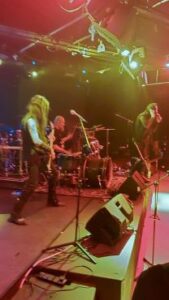
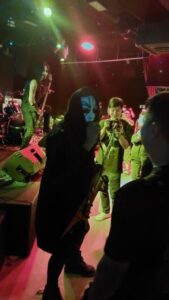
Headliners Sigh also have roots in the sub-genre of black metal, which values shrieking vocals, hectic and distorted guitars and copious allusions to occult, Satanic and pagan skulduggery, and is essayed by corpse-painted and pseudonym-laden musicians. Indeed, historically, Sigh’s black metal credentials are impeccable. They formed in 1989, heavily inspired by the black metal scene becoming popular – and soon notorious – in Scandinavia. A few years later, they were signed to the Norwegian label Deathlike Silence Records by Euronymous, co-founder of the band Mayhem. Yes, Euronymous was the bloke who’d be stabbed to death in 1993 by Varg Vikernes, of the band Burzum, during a period when the Norwegian black metal scene went down some very dark roads indeed.
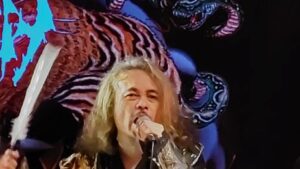
But in the three decades since – during which time, vocalist, keyboardist and bassist Mirai Kawashima has been the band’s leading light and one, enduring member – Sigh have also distinguished themselves with their willingness to experiment. Their sound has incorporated elements from classical music, traditional Japanese music and elsewhere, so that it’s earned such epithets as ‘avant-garde’ and ‘progressive’. Their eclectic-ness was certainly on display tonight. For example, their second singer and multi-instrumentalist Dr Mikannibal – according to Google AI, she’s actually a professor with ‘a doctorate in physics form the University of Tokyo’ – played a shamisen at one point and a saxophone at another. That was when she wasn’t pouring fake blood over her face from a goblet and shrieking sepulchrally. All good, ghoulish fun, by the way.
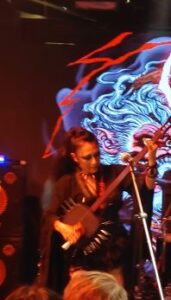
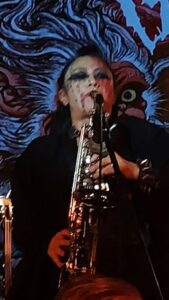
Their set – much of which was drawn from the 2007 album Hangman’s Hymn, which they re-recorded this year, and from the 2022 album Shiki – was a riot. It contained enough of the band’s original black metal lodestone to keep headbangers in the audience happy but offered plenty of other elements to ensure the proceedings felt fresh and unpredictable. The band’s look was great too. It was obviously influenced by such Japanese things as manga, kabuki and ukiyo-e – the colourful woodblock prints from the Edo period – as well as by Tim Burton and the traditional corpse-paint and general gruesomeness of black metal. I noticed how the guitarists had painted-on stitch-marks at the corners of their mouths, suggesting Kuchisake Onna, the fearsome slit-mouthed lady of Japanese urban myth. Though I don’t know what the black mask (or was it black gunk?) covering the face of the drummer was meant to represent. Anyway, he looked pretty fearsome too.
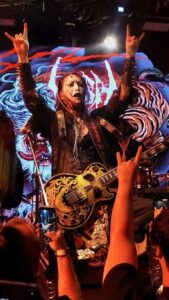
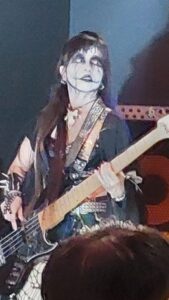
As I said, the crowd was relatively small, but the performers gave it their all. There was a splendid vibe and I had a great night. In my heavy metal live-music memories, this experience will be up there with seeing Megadeth (supported by Korn) in Chicago in 1995, or Motorhead (supported by Saxon) in Norwich in 2009. It didn’t matter that the attendance wasn’t massive. I tried explaining this to Tok Yathraa, whom I encountered at the end of the evening, after Sigh had finished their set. He looked slightly bemused by my enthusiasm. Well, I’d had a few beers by then.
One thing did put a dampener on the evening, though. Also after the gig’s end, I got talking to one of Phil Studio’s staff-members and learned from him that the venue will be closing down on November 2nd. This is thanks to an economically lethal cocktail of ‘high operational costs, compliance burdens, regulatory red tape, and double standards’. It comes in the wake of the closure two months ago of the Projector Cinema, a rare place in Singapore where you could get to see movies considered too niche to be shown in the city’s cineplexes. Oh dear, Singapore. If you keep on shedding your independent, alternative and idiosyncratic creative spaces like this, you’re going to end up as bland, corporate and culturally airless as Dubai… Or indeed, Edinburgh (see here, here and here).
